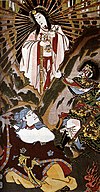San Marino Shrine
| San Marino Shrine | |
|---|---|
 Torii of the Shinto Shrine of San Marino | |
| Religion | |
| Affiliation | Shinto |
| Deity | Amaterasu |
| Location | |
| Geographic coordinates | 43°57′29″N 12°28′56″E / 43.95812°N 12.48215°E |
| Architecture | |
| Style | shinmei-zukuri |
| Date established | 2014 |
| Website | |
| https://www.sanmarinojinja.com/ | |
San Marino Shrine (サンマリノ神社) is a shrine in Serravalle, Republic of San Marino. It is the first official shinto shrine in Europe approved by the Jinja Honcho.[1][2][3]
History[edit]
Manlio Cadero planned the construction of the shrine in consultation with the Jinja Honcho. It was financed through the sale of 'Japan-San Marino Friendship Charity Gold Coins'.[4][5]
The shrine was founded on 21 June 2014, and opened to the public the following day. The San Marino shrine was inaugurated in the presence of 150 personalities including the president of the Association of Shinto Shrines and Yoko Kishi, mother of the former Prime Minister of Japan Shinzō Abe and daughter of Prime Minister Nobusuke Kishi.[6][7] The shrine was established at the initiative of the Japan San Marino Friendship Society (JSFS) in commemoration of the victims of the 2011 Tōhoku earthquake and tsunami.[8]
It is the first official shrine in Europe, recognized by the Association of Shinto Shrines (Jinja Honcho), while in the Netherlands the Yamakage Shinto Holland Saigu, a kamidana (home Shinto altar), was created privately in 1981.[9]
From 2019, marriages recognized by the Civil Registry office of the Republic of San Marino can be celebrated there, therefore valid throughout the world.[10]
Main shrine[edit]

The style of the main hall is Shinmei-zukuri, the same as that of the Ise Jingu.[11] In the shrine area there are also a torii (portal), a pair of tōrō (lanterns) and a small Chōzuya (ablution fountain), all very frequent elements in Shinto architecture.[12] The shine of San Marino consists of a small square-based monument with a side of 2.5 meters and made in Japan with cedar wood. Parts of the main hall were built using wood from the Ise Jingu shrine.
The main hall was built in Japan, dismantled and transported by sea to San Marino, where it was rebuilt by Japanese architects on a foundation made of typical sandstone.
The temple is surrounded by numerous rows of vines, set against the backdrop of the Mediterranean mountains and landscapes.
Deities[edit]
The Shrine of San Marino is consecrated to the kami Amaterasu, who in the Shinto pantheon personifies the deity of the Sun, the primary source of life on Earth. In Japanese mythology, Amaterasu is the first and most important of the Shinto deities, as according to tradition she is the creator of the Rising Sun archipelago and ancestor of the Japanese emperors. In fact, the legendary Jimmu, Japan's first emperor, is considered a direct great-grandson of the goddess Amaterasu.
Shinto priest[edit]

The Miyazukasa (chief Shinto priest) of the San Marino Shrine is Francesco Brigante (されたフランチェスコ・ブリガンテ), who received his Shinto priesthood status from the Shinto Shrine Honcho and was appointed as chief priest in 2013 and awarded the Bushidō honour . He is a local San Marino hotel owner who trained at Yudonosan Shrine in Yamagata Prefecture.[13]
Currently, the shrine is headed by Zenki Jinguji, who obtained his priesthood qualification to serve the San Marino Shrine at the Dewa Sanzan Shrine (Mt. Haguro) priesthood training school, also in Tsuruoka City, Yamagata Prefecture.
References[edit]
- ^ "SAN MARINO JINJA". San Marino Jinja. Retrieved 2023-10-15.
- ^ "SHRINE". San Marino Jinja. Retrieved 2023-10-15.
- ^ D, John (2016-08-01). "The curious case of San Marino". Green Shinto. Retrieved 2023-10-15.
- ^ "国民運動 « 日本会議". www.nipponkaigi.org. 18 January 2013. Retrieved 2024-01-21.
- ^ "日本の息吹". Nippon Kaigi. May 2013.
- ^ San Marino. Sarà inaugurato questa mattina alle 10.30 al podere Lesignano, il San Marino Jinja
- ^ "Un tempio shintoista a San Marino. E' il primo ufficiale in Europa". Il resto del Carlino (in Italian). 2014-06-22.
- ^ Stefano Carrer (2014-05-25). "Shintoisti a San Marino". Il Sole 24 ORE (in Italian). Retrieved 2023-09-13.
- ^ Adnkronos (2020-12-19). "A San Marino il primo tempio shintoista d'Europa". Adnkronos. Retrieved 2024-01-21.
- ^ "Cerimonie ed eventi". San Marino Jinja (in Italian). Retrieved 2024-01-21.
- ^ Un inno alla pace. Il tempio shinto a Lesignano è dedicato alle vittime del terremoto del 2011
- ^ "Shintoisti a San Marino". Il Sole 24 ORE (in Italian). Retrieved 2024-01-21.
- ^ "実はヨーロッパに輸出されている日本の神社|東條英利コラム - デイリーニュースオンライン". dailynewsonline.jp (in Japanese). 2014-11-09. Retrieved 2024-01-21.


